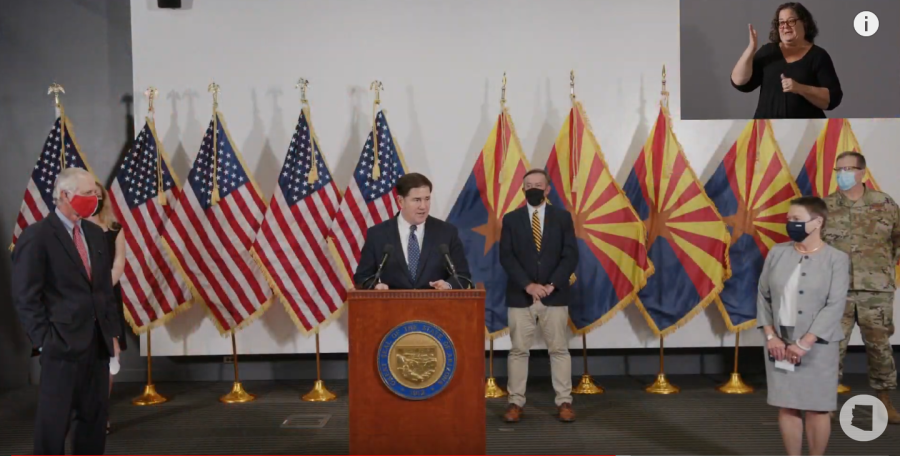Arizona Governor Doug Ducey held a press conference on Thursday, Sept. 24, to highlight the advances each university has made in regards to development and administration of COVID-19 tests, and to answer questions about COVID-19 protocols going forward.
RELATED: Campus reentry update: Robbins announces Phase 1 extension, crackdown on COVID-19 rules
Ducey started off the conference by announcing the state will invest $14 million into all three Arizona public universities to administer pre-existing testing protocols and develop new testing strategies. $8 million is directed toward developing pre-existing models of testing at each institution, and $6 million was to go towards the creation and distribution of a brand-new standard of testing, currently in the development process at Arizona State University.
ASU president Michael Crow elaborated on the new testing device during the conference, named “point of need” testing.
The test has individuals spit into a microfluidic device, which splits the DNA and RNA structures within a case’s saliva sample. Microchips in the device send copies of the RNA structure to a lab, where computational analysis determines if the RNA structure indicates a positive case.
According to Crow, ASU used a similar saliva-based test to help combat the Zika virus in 2017. ASU has already developed one of the first saliva-based tests in the state and is using that foundation to help with this new “point of need” method.
The new “point of need” testing method is expected to have high levels of accuracy and will report test results to patients within minutes – shortening the current test waiting period astronomically.
For Crow and ASU, however, “the hardest part will be getting testing production up to scale for the entire state.”
Crow predicted the tests could possibly be available in six months.
“This is a long-term thing and we have to take that approach. … Six months is the fastest we can do this, working day and night to get it done,” Crow said.
University of Arizona President Dr. Robert C. Robbins spoke briefly about the university’s testing efforts. Ducey commended Robbins and the university for their widespread antibody testing and for wastewater testing, a method used to analyze potential COVID-19 hotspots in entire buildings.
“Our universities are manufacturing PPE in new ways and are even testing wastewater. … Arizona universities are proving once again why they are the finest in the world,” he said.
Robbins and Arizona already used wastewater to identify outbreaks in multiple dorms, but during Thursday’s press conference, Robbins said the university will administer wastewater testing to off-campus housing – specifically in the high-rise apartments adjacent to the university.
“Our program is advancing wastewater testing technology for dorms, Panhellenic housing and now off-campus housing locations, specifically in the skyrises near Panhellenic housing,” Robbins said.
Tucson City Councilman Steve Kozachik previously identified that these high-rise apartments, with current tenant occupation rates as high as 90%, are expected to be intense COVID-19 hotspots.
As of Sept. 17, nearly 100 cases have been identified in the apartment complexes Hub at Tucson, and the newly constructed OliV. These complexes have been criticized for reported large gatherings, little social distance precautions and the availability of rooftop pools and spas, all factors leading to expected outbreaks in said apartment buildings.
Ducey also noted UA’s widespread antibody tests, a method of testing already identified by UA scientists to have little efficacy in confirming active positive cases but can indicate if an individual could have previously had the virus that causes COVID-19.
“The [UA] has promoted itself as a national leader, producing some of the best antibody tests in the country. This is a gold standard of testing,” Ducey said.
Robbins said the university performs around 6,000 antigen tests per week, with positivity rates of around 10% levels. However, aggregate positive cases are now at 2,224 as of Sept. 24, putting the UA in company with other schools having COVID-19 outbreaks greater than 1,200.
Arizona Department of Health Services Director Cara Christ also spoke to the expected rise of COVID-19 cases in multiple Arizona counties in the coming weeks.
“There are counties that may go into substantial spread in the coming weeks,” Christ said. “We do want to avoid closing down and implement strategies that mitigate the spread as much as possible.”
Ducey also spoke on Arizona’s commitment to remaining open, even among a potential third spike in some counties.
“Arizona is open,” Ducey said. “Arizona’s economy is open. Arizona’s education systems are open. Arizona’s tourism industry is open. The expectation is that we will remain open.”
Follow Ian Tisdale on Twitter









